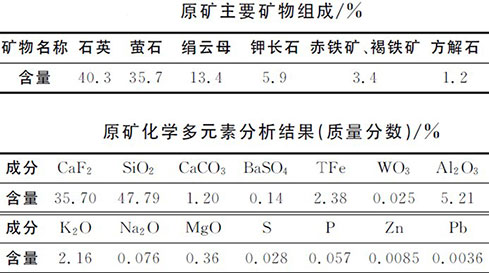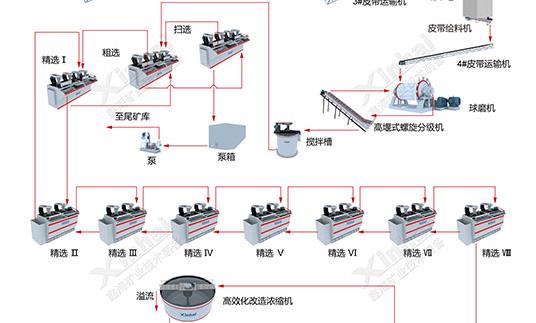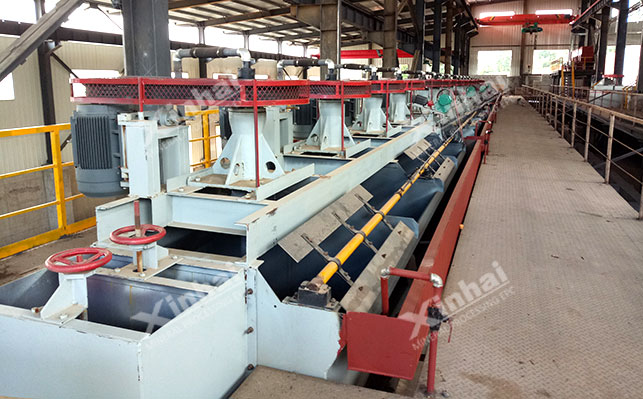
15311826613
Click to add WeChatFluorite is an important mineral raw material in modern industry. It is widely used in metallurgy, chemical industry and building materials. Many developed countries even reserve it as an important strategic material. Fluorite is also called fluorite. With the rapid development of fluorine chemical industry and other industries, the demand for fluorite ore powder has been directly driven. From the properties of fluorite ore, flotation is often used as the main method in the ore dressing process. The principle process is mostly crushing and screening-grinding-ore dressing-dehydration process. Then this article will introduce its fluorite ore dressing process with a certain case!
The main minerals of the ore are fluorite and quartz, followed by sericite and potassium feldspar, and contain a small amount of hematite, limonite, calcite, pyrite, etc. Through chemical element analysis, it is known that most of the useful mineral fluorite in the mineral is distributed in blocks, and the particle size is generally above 0.5mm; some fluorite is closely associated with minerals such as quartz, sericite, and pyrite, or encapsulates fine-grained quartz, sericite and other gangue minerals, and the inclusion particle size is mostly below 0.04mm, with an average of 0.01mm. Quartz is mainly anterior granular, vein-like distribution, and has a close relationship with fluorite, hematite and sericite. Hematite and limonite are mainly anterior granular, mostly impregnated, with extremely fine particle size, averaging 0.01mm, but are not closely related to fluorite dissemination.

Through the ore dressing test analysis of the fluorite mine, a two-stage grinding (concentrate II re-grinding and re-selection), one roughing, one scavenging, seven concentrating, middling 1 returned to scavenging, and the rest of the middling returned in sequence was designed.

Grinding fineness has a great influence on fluorite flotation index. If the grinding particle size is too coarse, the fluorite and other gangue minerals such as quartz in the mineral have not achieved monomer dissociation, and there are still intergrowths, which in turn affects the separation of fluorite concentrate; if the grinding particle size is too fine, although the monomer dissociation is achieved, over-crushing often occurs, resulting in low concentrate recovery rate. Therefore, it is necessary to determine the appropriate grinding process. For this fluorite, a two-stage grinding process was designed through multiple grinding fineness condition tests. The final concentrate grade, recovery rate and grinding cost selected grinding fineness of -0.074mm and content of 65%.

Its flotation process was finally designed as one roughing, one scavenging, seven concentrating, one return of the middling ore for scavenging, and the rest of the middling ore returned in sequence.
Roughing: Sodium carbonate (dosage of 1.5kg/t), water glass (dosage of 1.0kg/t), and tannic acid (dosage of 0.2kg/t) are used as inhibitors for minerals such as calcite and feldspar; XL-2 (dosage of 0.8kg/t) is used as a fluorite collector for a roughing operation.
Fine selection: Sodium carbonate dosage is 1.5kg/t, tannic acid dosage is 0.2kg/t, water glass dosage is 0.1 kg/t, XL-2 dosage is 0.8kg/t, and 7 concentrate operations are carried out under the condition of flotation concentration of 33.84%.
Regrinding: Because the grinding fineness is -0.074mm with a content of 65%, some fluorite still contains fine quartz, sericite and other gangue minerals. In order to obtain high-quality concentrate, it is necessary to regrind the concentrate. The final regrinding fineness is -0.074mm, accounting for 85%.

Finally, the fluorite ore concentrator obtained a concentrate product with a CaF2 grade of 97.82% and a recovery rate of 87.26%. The flotation process used by the concentrator is stable and reliable, and the process is simple.
The above is an introduction to the mineral processing flow of a fluorite mine. In an actual mineral processing plant, how to choose the fluorite mineral processing technology should be determined according to the properties of the fluorite ore. It is recommended to conduct mineral processing test analysis and design a suitable fluorite mineral processing process through analysis. Xinhai Mining can not only design suitable mineral processing processes for various fluorite ores, but also configure the mineral processing equipment required for each link according to the process plan, avoiding the manufacturer's running around to buy various equipment, and effectively avoiding various types of shirking and wrangling due to later equipment connection problems and installation and commissioning. Xinhai also has a professional installation and commissioning team that can carry out on-site installation and commissioning operations until the mineral processing plant is operating normally.